Thanks to Road Scholar for providing this lifelong learning adventure through the Greek Isles! As always, all opinions are our own.
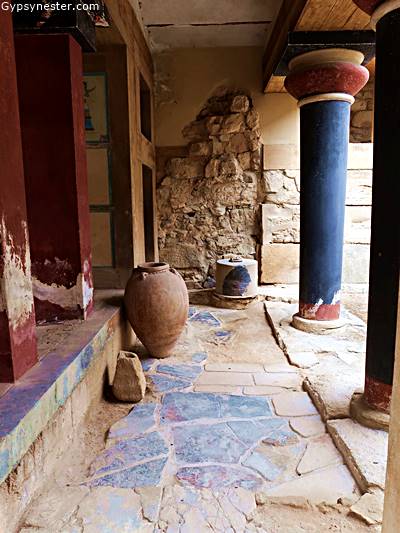
Even though it wasn’t the first stop on our Great Global Get-Together cruise through the Greek Isles, we begin our stories about the voyage on the island of Crete because ancient Greece might not have even existed without it.
No, that’s not an exaggeration, the Minoan civilization was based here and without them, along with the Mycenaean Greeks on the mainland, Greece would certainly be a very different place.
Beginning nearly five thousand years ago a society formed on Crete and over time became a precursor in art, architecture, and language to what we now know as Hellenistic culture.
 We began our exploration at the ruins of the palace of Knossos, and discovered just how influential Crete really was. As Europe’s oldest city and the mythological home of Minos, the first King of Crete and son of Zeus and Europa, this was instrumental in giving the entire continent its name.
We began our exploration at the ruins of the palace of Knossos, and discovered just how influential Crete really was. As Europe’s oldest city and the mythological home of Minos, the first King of Crete and son of Zeus and Europa, this was instrumental in giving the entire continent its name.
At one time it is thought that up to one hundred thousand people lived here, which would have made Knossos one of the world’s great cities.

Our first stop was the throne room, where kings of this vast city-state sat to rule. At least that was the original theory. Now scholars believe that this may have been strictly ceremonial and meant as a tribute to a mythological goddess.
Another character from mythology was most certainly believed to live here because the Labyrinth at the palace was the legendary home of the Minotaur, a half man half bull. The monster was born to Pasiphaë, Minos’s wife, after Poseidon made her fall in love with a bull.
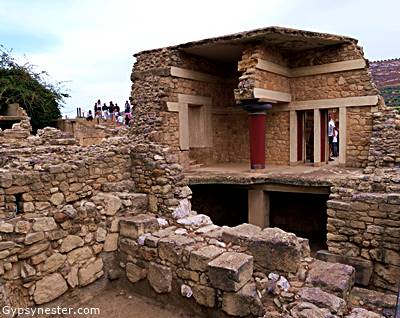 An actual labyrinth has never been found, leading some historians to speculate that the myth might have been simply a story to explain the horrifying noises coming from underground due to the many earthquakes in the region.
An actual labyrinth has never been found, leading some historians to speculate that the myth might have been simply a story to explain the horrifying noises coming from underground due to the many earthquakes in the region.
We won’t weigh in on that debate, but do lean toward the idea that no man with a bull’s head was running around here a few thousand years ago. We did find several non-mythological wonders at the palace though.
 Such as, the entire complex had a water and sewer system that would rival similar designs elsewhere in the world that didn’t become common until thousands of years later.
Such as, the entire complex had a water and sewer system that would rival similar designs elsewhere in the world that didn’t become common until thousands of years later.
Also the builders created structures with several floors, at least up to four, with ventilation airways built in, which was certainly unique for the time.

The art was equally impressive, with colorful columns on almost every building, huge frescoes adorning many walls, and highly decorated pottery giving a glimpse into their ancient lifestyle.
Although, depending on who you ask, many feel that the English archaeologist Sir Arthur Evans who excavated and restored much of the complex may have taken a few too many liberties with his restorations of the colors and artwork.
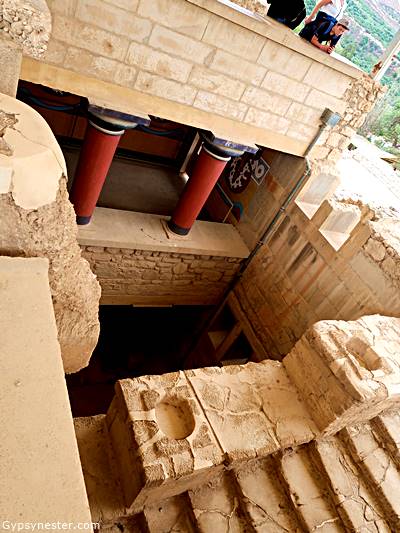 The site was discovered in 1878 by Minos Kalokairinos, but it was Evans who did most of the work beginning in 1900 and continuing for 35 years. Some archeologists think his recreations went off track into the realm of unfounded speculations.
The site was discovered in 1878 by Minos Kalokairinos, but it was Evans who did most of the work beginning in 1900 and continuing for 35 years. Some archeologists think his recreations went off track into the realm of unfounded speculations.
For a more academic view of the history, and a much better look at some of the artifacts, we made the Herakleion Archaeological Museum our next stop.
Widely considered to be one of the most significant museums in all of Europe, it holds relics from Cretan prehistory and history, covering a span of over five thousand years.
Much of the art includes various forms of sea life, which obviously was an important part of Minoan life. Frescoes, pottery, jewelry, and statues all feature octopus, dolphins, fish, and shells as decoration.

Many more featured bulls, which certainly seemed less logical. Perhaps some of the reason goes back to the Minotaur, but for whatever reason bulls were very important to the Minoans and maybe even worshiped.
One theme we saw repeatedly was bull leaping. Yup, men would take a running leap over a charging bull as part of a ceremony. Was this a part of their religion? Maybe, but no matter the reason for the crazy feat, the scene is immortalized in both sculptures and pictures.
Much of the art was ceramic, some functional such as pots of all sizes from tiny to giant, but a great deal was also simply decorative, such as figures and statues.

One of the more interesting displays had numerous larnakes, or clay coffins. Since these are only about three feet long, we first thought that the Minoans must have been very small. It turns out that the remains were either cremated or bent to fit into the terracotta chests.
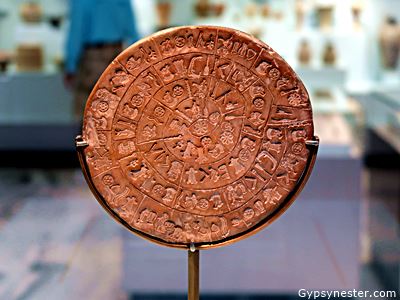 Perhaps the most significant piece in the museum is also one of the smallest, the Phaistos Disc. Discovered in palace of Phaistos, about twenty miles south of Knossos, this circular clay tablet is about six inches across and covered with symbols and characters thought to be from an alphabet or logograms.
Perhaps the most significant piece in the museum is also one of the smallest, the Phaistos Disc. Discovered in palace of Phaistos, about twenty miles south of Knossos, this circular clay tablet is about six inches across and covered with symbols and characters thought to be from an alphabet or logograms.
The 45 distinct signs appear 241 times in what might be some sort of story, but researchers have so far been unable to decipher the meaning. What is known is that this is one of the earliest examples of type setting ever as the symbols were pressed into the clay before firing.
Another thing we knew was that after all of this investigating, we were ready to eat.
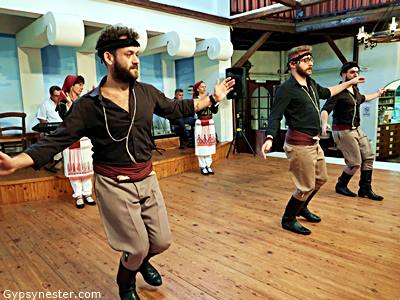 A trip to Arolithos Village, a near perfect replica of a traditional Cretan village would solve that, and provide us with some fun. Our entire group was treated to an old fashioned Greek meal, but before the food was served we worked up even more of an appetite with some music and dancing.
A trip to Arolithos Village, a near perfect replica of a traditional Cretan village would solve that, and provide us with some fun. Our entire group was treated to an old fashioned Greek meal, but before the food was served we worked up even more of an appetite with some music and dancing.
If ever there was the proper time to exclaim “Opa!” this was it.
David & Veronica, GypsyNester.com
See all of our previous adventures in Greece!
Thanks to Road Scholar for providing this lifelong learning adventure through the Greek Isles! As always, all opinions are our own.



This article opened my eyes, it seems very wonderful. I hope to see more articles like this. thanks for sharing.
You got a very great website, Glad I found it.
Thanks!
You could certainly see your enthusiasm within the paintings you write.